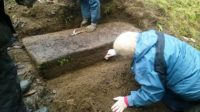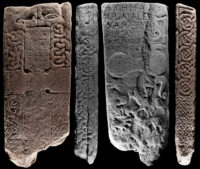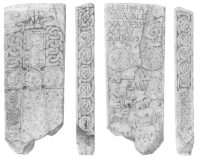 The Pictish symbol stone reused as a headstone in the 18th century that was discovered at an early Christian site near Dingwall in the Scottish Highlands has been confirmed to be an extremely rare cross slab. Found during a North of Scotland Archaeological Society (NOSAS) survey of a cemetery now on private land, the stone was embedded in the topsoil and partially covered by vegetation. NOSAS member Anne MacInnes spotted a foot carved on the surface and her fellow members confirmed it was a Pictish symbol stone. They reported it to the Highland Council archaeologist and the slab was excavated and safely removed.
The Pictish symbol stone reused as a headstone in the 18th century that was discovered at an early Christian site near Dingwall in the Scottish Highlands has been confirmed to be an extremely rare cross slab. Found during a North of Scotland Archaeological Society (NOSAS) survey of a cemetery now on private land, the stone was embedded in the topsoil and partially covered by vegetation. NOSAS member Anne MacInnes spotted a foot carved on the surface and her fellow members confirmed it was a Pictish symbol stone. They reported it to the Highland Council archaeologist and the slab was excavated and safely removed.
When the stone was first found, it was reverse side up, the name and date of the deceased inscribed on the upper left corner. There was no cross on the exposed side, and because the back was coated with soil, when the slab was lifted archaeologists couldn’t see whether there was a cross carved on the other side either. Until they cleaned it, they wouldn’t know if it was one 350 or so extant symbol stones or in the much more elite club of 50 Pictish cross slabs.
 Now that it has been cleaned and dried, the cross on the obverse is clear, but that’s not the only notable feature. The intricate cross is flanked on both sides by toothy beasts who, with massive canines and lolling tongues, face each other over the top of the cross. The fanged serpent-like creatures are unique in the iconography of Pictish carving. The imagery on the reverse of the stone — oxen, an animal-headed armed warrior, a double disc, a z rod symbol — are traditional Pictish symbols seen on other cross slabs.
Now that it has been cleaned and dried, the cross on the obverse is clear, but that’s not the only notable feature. The intricate cross is flanked on both sides by toothy beasts who, with massive canines and lolling tongues, face each other over the top of the cross. The fanged serpent-like creatures are unique in the iconography of Pictish carving. The imagery on the reverse of the stone — oxen, an animal-headed armed warrior, a double disc, a z rod symbol — are traditional Pictish symbols seen on other cross slabs.
It is believed to have been carved around 1,200 years ago, during the period when the Picts were becoming Christianised. […] This find has been described as being ‘of national importance’ by experts, as it is one of only 50 complete or near-complete Pictish cross-slabs known, and one of the first to be found on the Scottish mainland for many years. It is also the first object of this type found in this location and therefore suggests that the site dates back much further than was previously thought.
 The cross slab needs further conservation and repair before it can be put on display at Dingwall Museum in Easter Ross. Most of the work will be funded by grants, but the NoSAS and The Pictish Arts Society have started a crowdfunding campaign to raise the remaining £20,000. With £12,208 raised from 106 supporters, the campaign is at 61% of the target.
The cross slab needs further conservation and repair before it can be put on display at Dingwall Museum in Easter Ross. Most of the work will be funded by grants, but the NoSAS and The Pictish Arts Society have started a crowdfunding campaign to raise the remaining £20,000. With £12,208 raised from 106 supporters, the campaign is at 61% of the target.
A so-called “Khachkar”, also known as an Armenian cross-slab (from խաչ xačʿ “cross” + քար kʿar “slab”) bears a cross and often additional motifs like a rosette or solar disc and elaborate patterns of leaves, grapes etc. Those Khachkars are characteristic of Medieval Christian Armenian art. The oldest one with a known date was carved in 879AD, but earlier and cruder examples do exist.
Early khachkars were erected for the salvation of the soul of either a living or a deceased person, to commemorate a military victory, the construction of a church, or protection from natural disasters. Many ended up in graveyards or notably (Th/d)ingwalls, and would even be conform to what happened to this cross slab in 1796, after the cross had been added to it apparently much earlier.
:hattip:
——-
PS: Any suggestions what the flip side may represent? Obviously a viking dude with a dog and a cow receives the gospel and the Evangelists might be represented particularly by the dude himself, the winged bull, the lion …and maybe there is an eagle anywhere on the slab as well? Is the winged bull bringing the cross, a battle axe or maybe both? Could the winged bull be the eagle as well?
There looks to be a very strange looking human with a large enough on one of the slabs.????